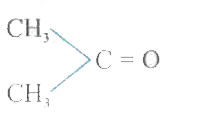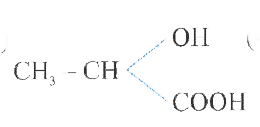An aldehyde reacts with KCN to form cyanohydrin. In this reaction
CN− acts as nucleophile and does nucleophilic addition
CN− acts as nucleophile and does electrophilic addition
CN− acts as an electrophilic and does electrophilic addition
CN− acts as nuclcophile and does nucleophile substitution
The correct Answer is:A
To solve the question regarding the reaction of an aldehyde with KCN to form cyanohydrin, we can break down the process step by step.
1. Identify the Reactants:
- We have an aldehyde (for example, acetaldehyde, CH₃CHO) and potassium cyanide (KCN).
2. Dissociation of KCN:
- In solution, KCN dissociates into potassium ions (K⁺) and cyanide ions (CN⁻). The cyanide ion (CN⁻) is the active species in this reaction.
3. Nucleophilic Attack:
- The carbon atom of the carbonyl group (C=O) in the aldehyde is electrophilic due to the partial positive charge on it. The cyanide ion (CN⁻), being electron-rich, acts as a nucleophile and attacks the electrophilic carbon atom.
4. Formation of Tetrahedral Intermediate:
- Upon the nucleophilic attack, the double bond between carbon and oxygen breaks, leading to the formation of a tetrahedral intermediate. The oxygen atom now carries a negative charge (alkoxide ion).
5. Protonation of the Alkoxide Ion:
- In the presence of water (during hydrolysis), the alkoxide ion (O⁻) can be protonated by a water molecule, leading to the formation of the hydroxyl group (–OH).
6. Formation of Cyanohydrin:
- The final product of this reaction is a cyanohydrin, which contains both a hydroxyl group (–OH) and a cyano group (–CN) attached to the same carbon atom.
Conclusion:
The reaction of an aldehyde with KCN results in the formation of cyanohydrin through a nucleophilic addition mechanism.
- We have an aldehyde (for example, acetaldehyde, CH₃CHO) and potassium cyanide (KCN).
- In solution, KCN dissociates into potassium ions (K⁺) and cyanide ions (CN⁻). The cyanide ion (CN⁻) is the active species in this reaction.
- The carbon atom of the carbonyl group (C=O) in the aldehyde is electrophilic due to the partial positive charge on it. The cyanide ion (CN⁻), being electron-rich, acts as a nucleophile and attacks the electrophilic carbon atom.
- Upon the nucleophilic attack, the double bond between carbon and oxygen breaks, leading to the formation of a tetrahedral intermediate. The oxygen atom now carries a negative charge (alkoxide ion).
- In the presence of water (during hydrolysis), the alkoxide ion (O⁻) can be protonated by a water molecule, leading to the formation of the hydroxyl group (–OH).
- The final product of this reaction is a cyanohydrin, which contains both a hydroxyl group (–OH) and a cyano group (–CN) attached to the same carbon atom.
The reaction of an aldehyde with KCN results in the formation of cyanohydrin through a nucleophilic addition mechanism.
Topper's Solved these Questions
Similar Questions
Account for the following
Chloromethane reacts with KCN to form ethanenitrile as the main product and wit AgCN to form methyl isocyanide as the chief product.
View SolutionAccount for following :
Chloromethane reacts with KCN to form ethane nitrile as main product and with AgCN to form methyl isocyanide as chief product.
View Solution
Knowledge Check
CuSO4 reacts with KCN to form
ACu(CN)2BCuCNCK2[Cu(CN)4]DK3[Cu(CN)4]Acetaldehyde on treatment with HCN forms a cyanohydrin. What will be the product if this cyanohydrin is further hydrolysed ?
ACH3COOHB C
C DCH3CH2OH
DCH3CH2OHBenzaldehyde reacts with ethanolic KCN to give
AC6H5CHOHCNBC6H5CHOHCOOHCC6H5CHOHCOC6H5DC6H5COCOC6H5+.
Benzaldehyde reacts with ethanoic KCN to give
View SolutionCuSO4 reacts with excess KCN to form
View SolutionBenzaldehyde reacts with alcoholic KCN to give :
View SolutionAssertion: Haloalkanes react with KCN to form alkyl cyanides as main product while with AgCN form isocyanide as the main product.
Reason: KCN and AgCN, both are ionic compounds.
View SolutionKCN reacts to form cyanide with :
View Solution
